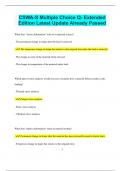Exam (elaborations)
CSWA-S Multiple Choice Q- Extended Edition Latest Update Already Passed
- Course
- Institution
CSWA-S Multiple Choice Q- Extended Edition Latest Update Already Passed What does "elastic deformation" refer to in material science? - The permanent change in shape after the load is removed. - The temporary change in shape that returns to the original form after the load is removed. - The...
[Show more]



